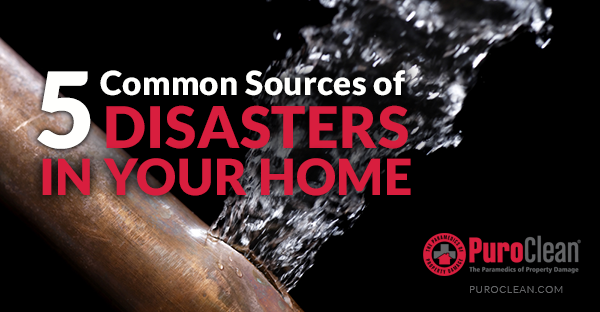Water Damage – Prevention is the Best Medicine
Incoming washing machine hoses are one of the most common sources of flood damage in a residence. Granted, the water comes from a clean source, but it still flows everywhere when it bursts. With so many families away for the entire day, one broken hose can release a tremendous amount of water in a few short hours. The best solution is to simply turn the hose valves on and off as we start and finish the task of washing clothes. The hose is under constant pressure 24/7. It is inevitable that it will weaken and burst over time.
Many manufacturers post a small notice to replace the hoses every five years, but that notice is seldom seen and even more seldom followed. There is, however, one very simple way of avoiding the problem. Replace the standard hoses with wire-braided, high-pressure hoses. You can get them at almost any hardware supply store. This is something that everyone should do as soon as possible. It’s not a question of if but only when a hose is going to burst. So replace them now.
This also brings up the subject of other water lines that need preventative maintenance. There is a big difference between a bursting hose from a washing machine and a dripping icemaker inlet line. Water damage that occurs over an extended period of time due to poor maintenance is often not covered in an insurance policy and yet can cause major damage.
Continual, slow leaks can migrate under vinyl, stone and other flooring without notice. If you do not check them once a month, you can have a very expensive loss that might not be covered by insurance. So, at least once a month move the refrigerator or other appliances and physically check for any damage or signs of a leak.
Water line connections that attach to the dishwasher, reverse osmosis lines, or any other water line should also be checked on a regular basis. Get under the sink and feel the lines for moisture. Look on the deck of the cabinet for any drips that are collecting or for signs of wet or damaged materials.
Ice damming can cause water to enter a house as well. The distance from the eve of a roof to the wall is called the soffit. It is the outside perimeter area that overhangs and protects the walls from water when it rains. When insulation in the attic does not reach the exterior wall, the heat in the home in the winter is transmitted from the interior of the house to the attic. Close to this area of heat loss is the actual roof and just a little bit of heat from this situation (improper insulation) can begin to melt the snow on the roof, which then runs into the gutter.
At night or other times of colder temperatures, the melted snow re-freezes forming ice in the gutter. Once the gutter is full, the ice begins to dam and then re-freeze. If left unchecked, this ice dam begins to build back up the slope of the roof. Eventually, the freezing/melting ice can penetrate under the shingles and sheathing and into the attic/living area. Water damage then appears on the ceilings of the rooms under this area. Again, this is a maintenance/construction issue and may not be covered under a homeowner insurance policy.
How can you prevent this damage? The answer is to be sure to insulate and ventilate your attic properly. You may need to have a professional insulation company conduct an inspection and evaluate the installation of the insulation and assess the R-value of the insulation in the attic. They will most likely recommend blowing in more insulation to protect the home from heat loss. But in addition to the new insulation, you will also need to make sure that the attic is properly ventilated. Air movement prevents condensation and helps eliminate other potential water problems.
You should also check your toilets for leaks. A leaky toilet can waste as much as 100 gallons of water each day. Test for leaks by putting a few drops of food coloring in the tank, then watch for a few minutes. If the color appears in the bowl, you have a leak. Repair your toilet, and it will save you time, money, and hopefully heartache from unnecessary potential damage to your home.


